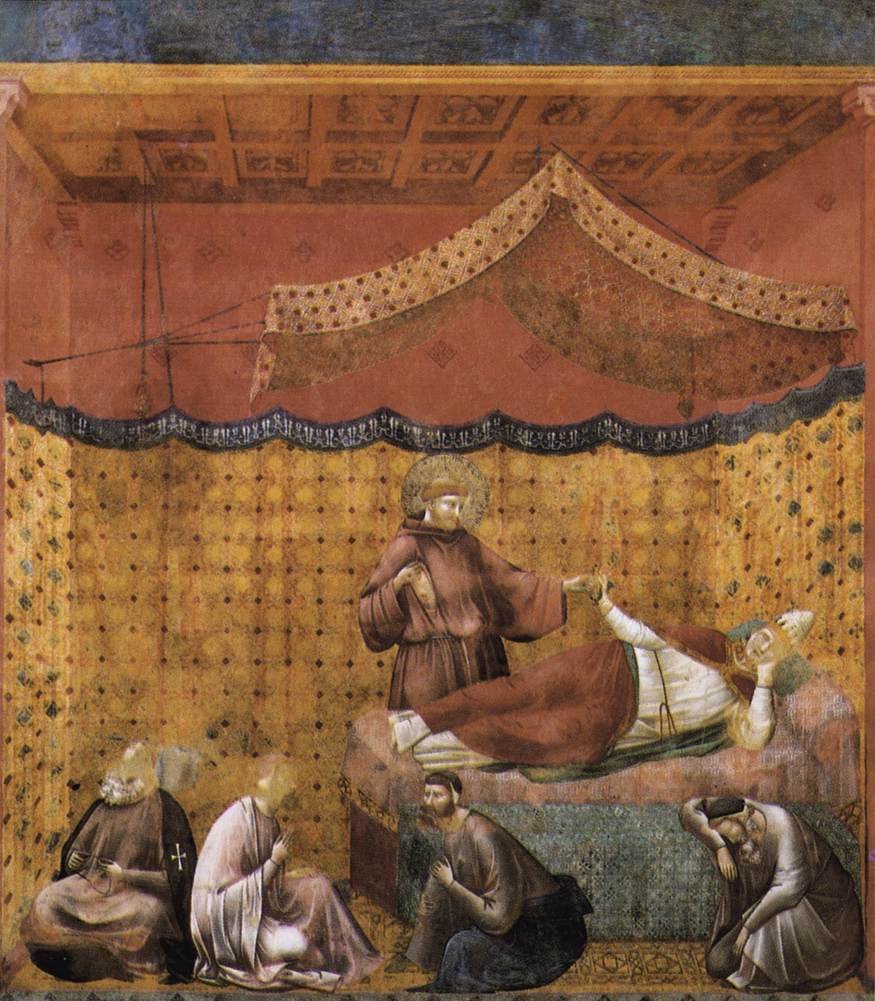About Saint Francis
Page 4
19. Francis receives the stigmata on the mountain of La Verna
Two years before he returned his spirit to heaven, he was led by divine providence to a high place apart called Mount La Verna. On a certain morning about the feast of the Exaltation of the Cross, while Francis was praying on the mountainside, he saw a Seraph having six wings, fiery as well as brilliant, descend from the grandeur of heaven. And when in swift flight it had arrived at a spot in the air near the man of God, there appeared betwen the wings the likeness of a man crucified, with his hands and feet extended in the form of a cross and fastened to a cross. Two of the wings were raised above his head, two were extended for flight, and two covered his whole body. Seeing this he was overwhelmed and his heart was flooded with a mixture of joy and sorrow. He rejoiced at the gracious way Christ looked upon him under the appearance of the Seraph, but the fact that he was fastened to a cross pierced his soul with a sword of compassionate sorrow. As the vision was disappearing, it left in his heart a marvellous fire and imprinted in his flesh a likeness of signs no less marvellous. For immediately the marks of nails began to appear in his hand and feet just as he had seen a little before in the figure of the man crucified. His hand and feet seemed to be pierced through the centre by nails, with the heads of the nails appearing on the inner side of the hands and the upper side of the feet and their points on the opposite sides. The heads of the nails in his hands and his feet were round and black; their points were oblong and bent as if driven back with a hammer, and they emerged from the flesh and stuck out beyond it. Also his right side, as if pierced with a lance, was marked with a red wound from which his sacred blood often flowed.
Cf. St. Bonaventure's Major Legend of St. Francis, XIII:3
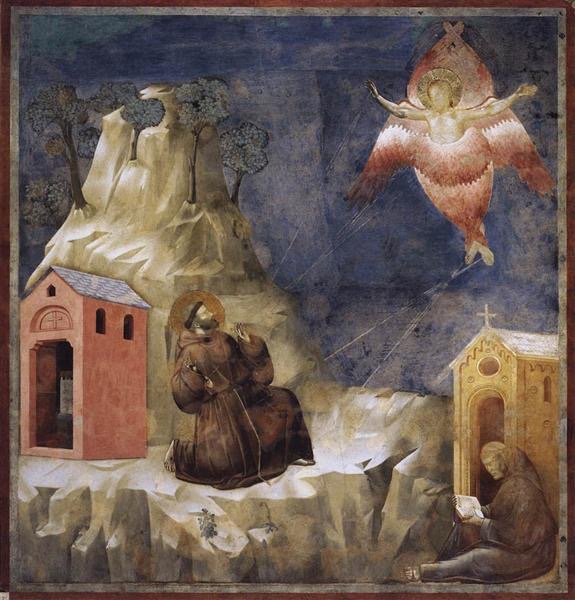
20. The death and apotheosis of St. Francis
Since he could not walk because of the nails protruding from his feet he had his half-dead body carried through the towns and villages to arouse others to carry the cross of Christ. He used to say to the brothers,"Let us begin, brothers, to serve the Lord our God, for up to now we have done little."
Two years after the imprinting of the sacred stigmata, that is in the twentieth year of his conversion, he asked to be taken to Saint Mary of the Portiuncula, so that he might yield up the spirit of life where he had received the spirit of grace. When he had been brought there, he threw himself in fervour of spirit totally naked on the naked ground. Lying like this on the ground stripped of his sackcloth garment, he lifted up his face to heaven and covered with his left hand the wound in his right side, so that no one would see it. And he said to his brothers, "I have done what is mine, may Christ teach you yours." When the hour of his passing was approaching, he had all the brothers called to him and exhorted them to divine love with fatherly affection. He stretched his hand over them, crossing his arms in the form of a cross, for he always loved this sign.
At last, when all the mysteries were fulfilled in him and that most holy soul was released from the flesh and absorbed into the abyss of divine light, the blessed man fell asleep in the Lord.
Cf. St. Bonaventure's Major Legend of St. Francis, XIV:1-6
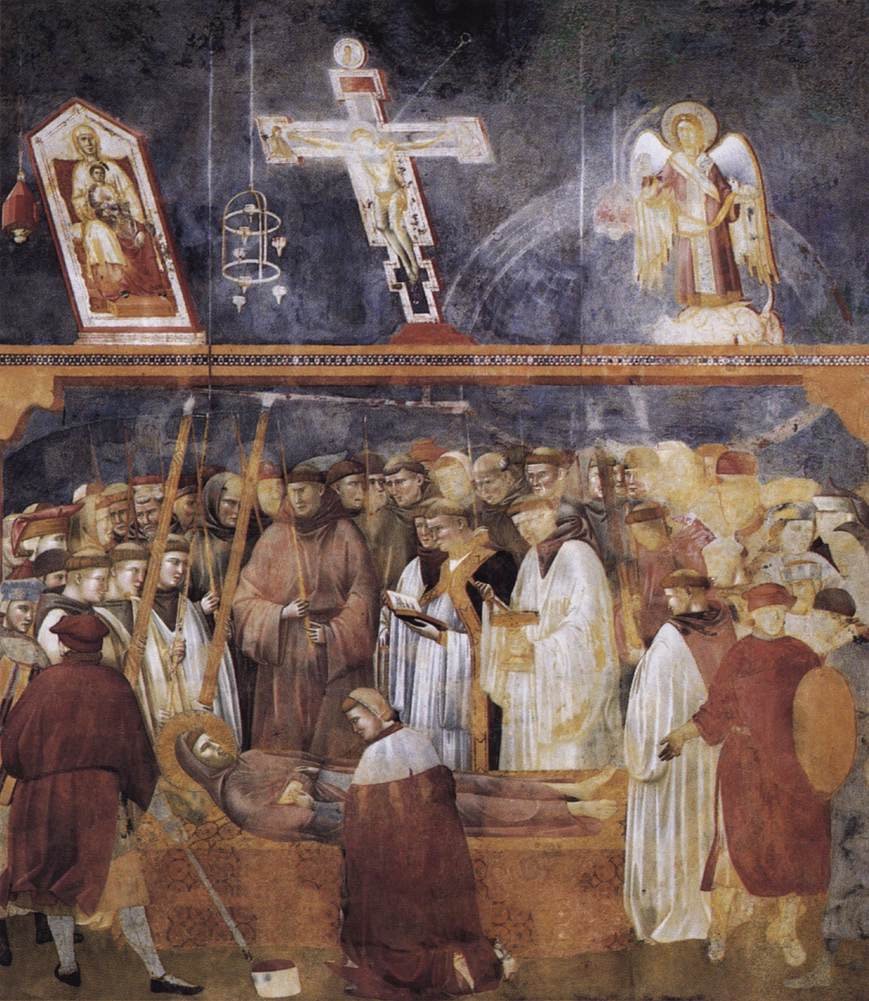
21. Francis at the moment of his death appears simultaneously to a Minister Provincial and to the Bishop of Assisi
At that time the minister of the brothers in Terra di Lavoro was Brother Augustine, a man both holy and upright, who was in his last hour and had already for some time lost his speech. In the hearing of those were standing about, he suddenly cried out, "Wait for me, father, wait! Look I'm coming with you!" The amazed brothers asked him to whom he was speaking so boldly. And he replied, "Don't you see our father Francis going to heaven?" And immediately his holy soul, leaving the flesh, followed the most holy father.
At that time the bishop of Assisi had been at the shrine of Saint Michael on Monte Gargano because of a pilgrimage. Blessed Francis appeared to him on the night of his passing and said, "Behold, I am leaving the world and am going to heaven." When he rose in the morning the bishop told his companions what he had seen, and returning to Assisi, he carefully inquired and found out with certainty that the blessed father had departed this world at the very hour when he had appeared to him in this vision.
Cf. St. Bonaventure's Major Legend of St. Francis, XIV:6
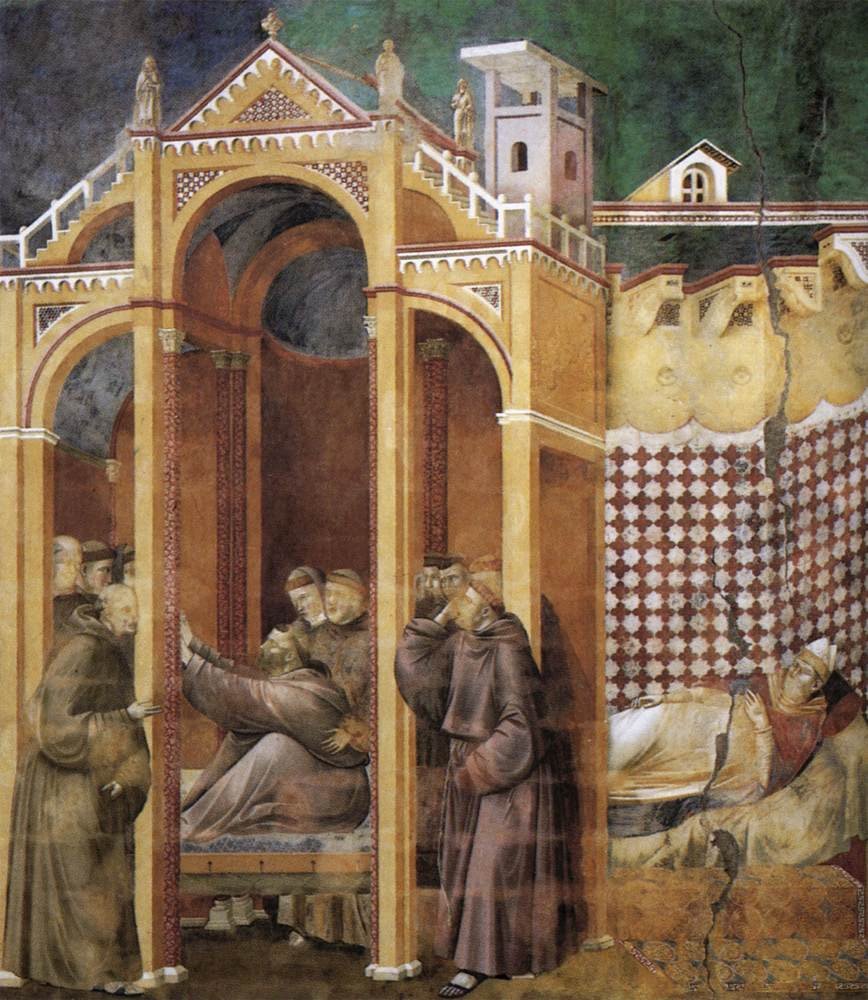
22. An Assisi nobleman verifies the stigmata of Francis
When the people heard of the passing of our blessed father and news of his miracles had spread, they hurried to the place to see with their own eyes so that they could dispel all doubt and add joy to their love. A great number of the citizens of Assisi were admitted to contemplate those sacred marks with their own eyes and to kiss them with their lips. One of them, a knight who was educated and prudent, Jerome by name, a distinguished and famous man, had doubts about these sacred signs and was unbelieving like Thomas. Fervently and boldly, in the presencce of the brothers and the citizens, he did not hesitate to move the nails and to touch with his hands the saint's hands, feet, and side. While he was examining with his hands these authentic signs of Christ's wounds, he completely healed the wound of doubt in his own heart and the hearts of others. As a result, later along with others, he bacame a firm witness to this truth that he come to know with such certainty and he swore to it on the Gospel.
Cf. St. Bonaventure's Major Legend of St. Francis, XV:4
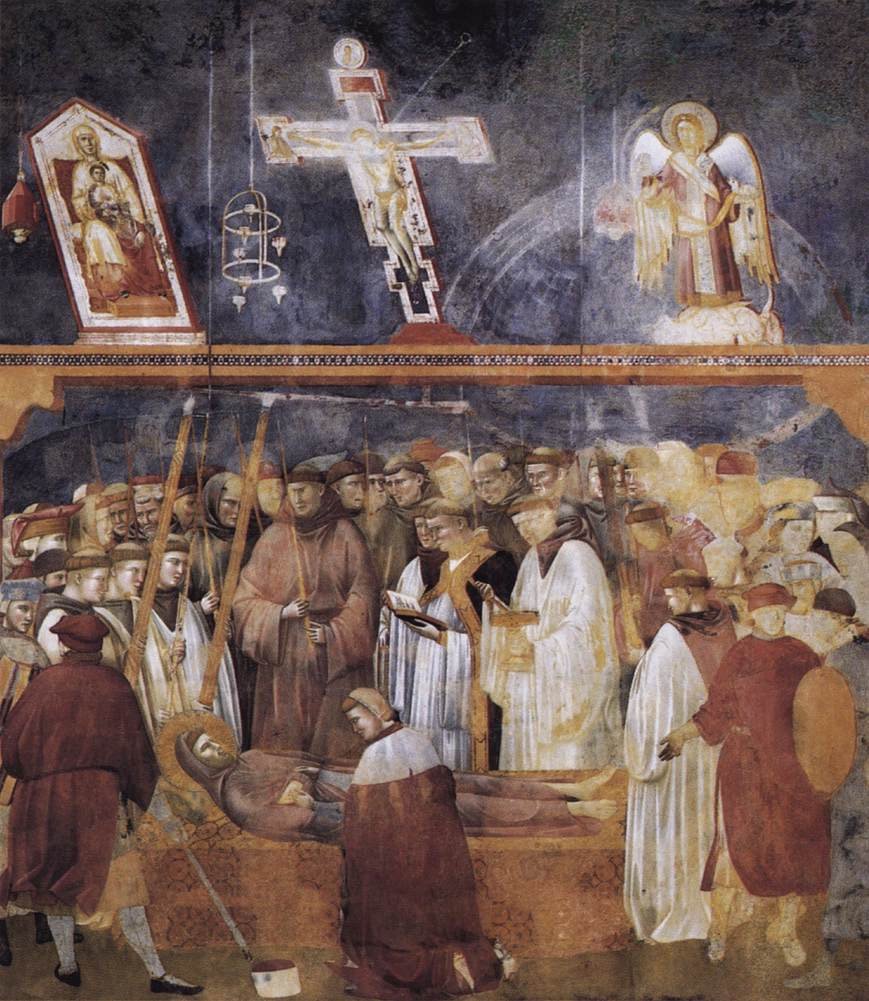
23. The sacred remains of Francis are venerated by St. Clare at San Damiano
His brothers and sons, who had been called to their father's passing, with the whole multitude of people, spent that night, in which the blessed confessor of Christ departed, in the divine praises. They did this in such a way that it seemed to be a vigil of angels, not a wake for the dead. When day was breaking, the crowds that had assembled took branches from the trees and carried his sacred body to the city of Assisi, with a blaze of many candles and hymns and songs. As they passed the church of San Damiano, where the noble virgin Clare was then living enclosed with the virgins, they stopped for a while so that these holy nuns could see and kiss his sacred body, adorned with its heavenly pearls. Finally reaching the city with great rejoicing, with all reverence they place the precious treasure they were carrying in the church of Saint George.
There as a boy he learned his letters, there he later preached for the first time, and there, finally, he received his first place of rest.
Cf. St. Bonaventure's Major Legend of St. Francis, XV:5
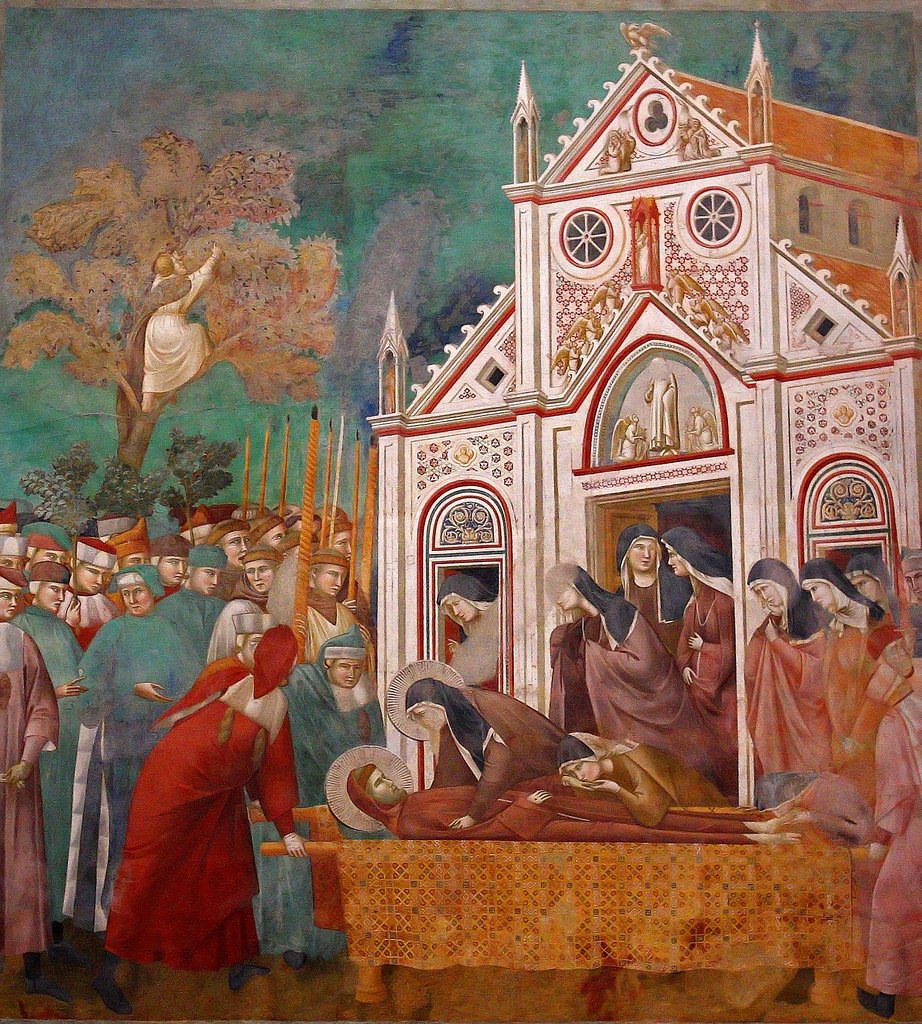
24. Gregory IX declares Francis a saint with a solemn canonization in Assisi
That shepherd of the Church, Pope Gregory IX, was fully convinced of Francis's remarkable holiness, not only from hearing of the miracles after his death, but also from his own experience during his life. He had no doubt that Francis was glorified in heaven by the Lord. In order to act in conformity with Christ, whose vicar he was, after prayerful consideration he decided to glorify him on earth by proclaiming him worthy of all veneration. In order to certify to the whole world the glorification of this most holy man, he had the known miracles recorded and attested to by appropriate witness. These he submitted to the examination of those cardinals who seemed less favourable to his cause. This material was examined carefully and approved by all. He decreed, with the unanimous advice and assent of his brothers and all the prelates who were then in the curia, that Francis should be canonised. Gregory came personally to the city of Assisi in the one thousandth, two hundredth, and twenty-eighth year of the Incarnation of the Lord, on the seventeenth day of the calends of August, a Sunday, and enrolled the blessed father in the catalogue of the saints, in a great and solemn ceremony that would be too long to describe.
Cf.St. Bonaventure's Major Legend of St. Francis, XV:7
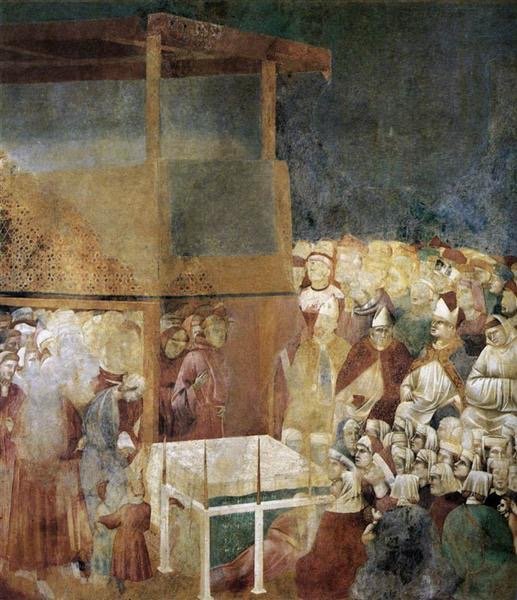
25. St. Francis appears to Gregory IX to assure him of the reality of his stigmata
Before he had inscribed Francis, this standard-bearer of the cross, in the catalogue of the saints, the Lord Pope Gregory the Ninth, of happy memory (about whom this holy man had prophetically foretold that he would be raised up to the apostolic dignity), carried a certain scruple of doubt in his heart about whether Francis had really received a wound in his side. But one night -- as that blessed pontiff himself used to tell with tears in his eyes -- blessed Francis appeared to him in a dream with a certain show of sternnes in his face. Reproving him for his inner uncertainty, blessed Francis raised up his right arm, uncovered the wound on his side, and asked him for a vial in which to gather the spurting blood that flowed from it. In the dream the Supreme Pontiff brought him the vial he requested, and it seemed to be filled to the brim with the blood which flowed abundantly out of the side. From that day he began to feel such devotion towards this sacred miracle, and to burn with such a zeal for it, that he would not allow anyone to obscure these signs with arrogant presumption without striking him with a severe rebuke.
Cf. St. Bonaventure's Major Legend of St. Francis - The Miracles, I:2
Gregory IX promulgated three declarations in 1237 praising the Stigmata of Francis, and defending their genuineness against those who would attack them.
